Slacklining is a fun outdoor activity for the whole family, and you don’t need to be an expert slackliner to share slacklining with your kids.
We love to slackline and are here to help you pick the best slacklines for kids!
In this post:
- What is a slackline?
- Considerations When Buying a Slackline for Kids
- Best Overall Slackline for Kids
- Best Long Slackline for Kids
- Best Budget Slackline Kit
- Best Beginner Trick Slackline
- Learning to Slackline
- Safety
- Maintaining Your Slackline
- FAQs
What is a slackline?
A slackline is a 1 to 2-inch wide piece of webbing that is stretched between trees or other anchors using a tensioning system like a ratchet. Once in place, you can balance, walk, and do tricks on the line.
Walking on the line takes a while to learn, but slacklining can be fun, even when you’re a beginner. It’s excellent for building perseverance and determination! Not to mention the added physical benefits like balance, stability, and coordination.
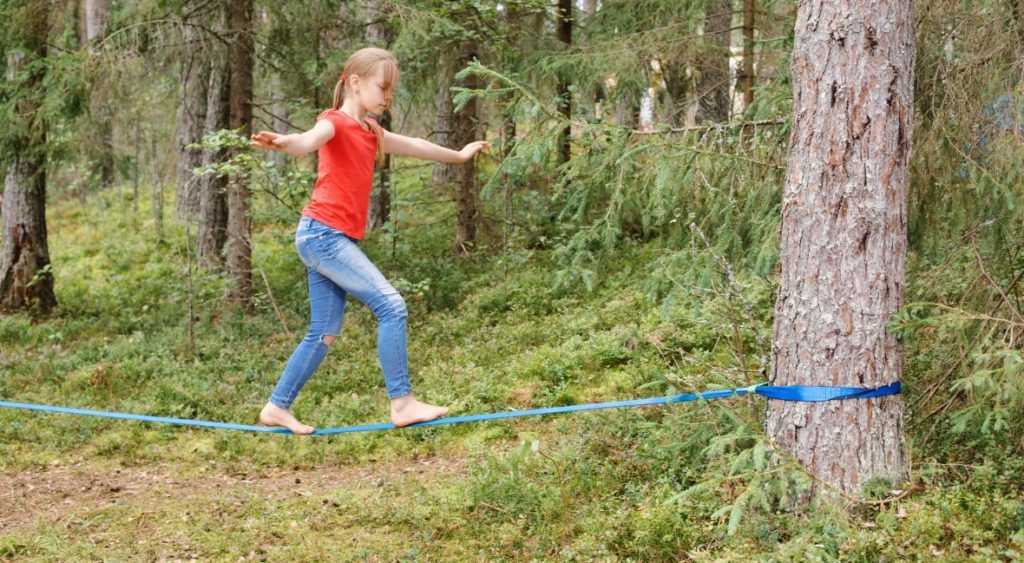
We get commissions for purchases made through links in this post. As an Amazon Associate, we earn from qualifying purchases.
You can set up a slackline at a park if you don’t have enough space or big enough trees in your backyard. The whole setup is relatively light and easy to take with you. Set up is easy, requires only one person, and takes only a few minutes.
- Looking for more outdoor fun? Check out our complete guide on paintball for kids!
Considerations When Buying a Slackline for Kids
Kids don’t need any kid-specific slackline, but some slackline kits are easy to use and great for all levels. When buying a slackline, it is essential to consider:
- Length. How far apart are the trees in your backyard or park? You want to make sure that you end up with a slackline that is long enough. When looking at the total length of a slackline, remember that it has to go around both trees and still have some line left over to go through the ratchet. A 60-foot slackline is too short to be placed between two trees that are 60 feet apart.
- Accessories. Consider how much value is added by things like a carry case, overhead training line, or ratchet cover. Will you use them, or should you look for a set without them? Don’t pay for extra features like an overhead training line if you will learn by holding a friend’s hand.
- Your intended use. Are you looking for a fun slackline to put up in the backyard a few times a year, or are your kids looking to continue improving and learning new skills? Generally, a shorter distance is easier for beginners and a longer line provides more challenge as you improve. If advancing is the goal, a longer line might serve your family longer. Another consideration would be the stretchiness of the slackline. A stretchier line provides more bounce and allows for tricks.
Here are our favorite slacklines for kids.
Best Overall Slackline for Kids: ZenMonkey 60ft Slackline Kit with Overhead Training Line

This slackline kit comes with everything you need to get started! High-quality webbing and ratchet make this a robust kit and make setup easy. Sling the webbing around two trees, feed it through the ratchet, tension the line, and you’re ready to go.
The ratchet is rated to 5 metric tons and is attached to an 8-foot length of webbing to fit around even large-diameter trees. The webbing has limited stretch and is easy to tension. The included tree protectors are extra big (5 feet long) and protect both trees and slackline from wear.
The kit comes with an overhead training line to help you balance and stay on the line while learning. The overhead training line is used in conjunction with a strap that allows beginners to practice keeping their arms high. The arm strap is slung over the overhead line. It shifts and moves with you but helps to keep you on the line while you work on your balance.
Pros
- 60 ft in length
- Comes with tree protectors, overhead training line, overhead arm trainer, and carrying bag
- Easy to set up and take down with easy-to-follow instructions
Cons
- The height of the overhead training line will need to be adjusted if being used by both kids and adults.
- Not designed to be a trick line
- You may want a longer line when you advance.
Check prices for ZenMonkey Slackline Kit
Best Long Slackline for Kids: Gibbon Slacklines Classicline XL with treewear, 82ft

Gibbon Slacklines has been around for years and was one of the first companies to make a slackline kit.
We’ve had an earlier iteration of this slackline for years, and it is still going strong! It’s a family staple for days at the park. Expect to attract curious families. We tote ours around in a reusable grocery bag since it doesn’t come with a carrying bag.
This kit is a stellar option if you’re looking for a more minimal set or a longer slackline. The length gives the slackline lots of versatility. It can be set up over shorter distances and slowly lengthened as you build confidence making it a great slackline as you and your kids advance. This gives you room to grow. It also works well for spaces where trees are few and far between.
The line doesn’t have too much stretch and is easy to tension and release. (Follow the directions to avoid hurting fingers.) The ratchet is designed with double gearboxes on both sides to help it last longer.
It doesn’t come with an overheard training line, but it is only used when you are a beginner, and you can undoubtedly learn without one. Use a friend for balance instead.
Pros
- Extra-long
- Includes tree protection and ratchet cover
- Extra robust ratchet
- Thick webbing
- Comes with an app
Cons
- More expensive
- Doesn’t include overhead training line or carrying bag
- Each tree protector is only 40 inches and is too small to fit all the way around bigger trees
- Not designed to be a trick line
Check prices for Gibbon Classicline XL
Best Budget Slackline Kit: Zero Gravity Slacklines Slackline Kit with Storage Bag

This slackline kit comes with everything you could need as a beginner. Like the others in this list, it is tensioned with a ratchet system, making it a breeze to set up. The ratchet is duel geared, making it extra durable, and the line is rated to hold up to 315 pounds.
It comes with an overhead training line and an arm training strap so kids can practice for hours without needing a hand to lean on. The webbing is ideal for beginners as it is not too bouncy or stretchy and offers a nice stable slackline.
It comes with an extra durable and large carrying case that makes it easy to take the slackline on all your park adventures.
Pros
- Includes overhead training line, arm training strap, tree protectors, and storage bag
- Easy to set up and take down
- Durable
- Inexpensive
Cons
- Only 52 ft – short length limits places it can be set up
- Doesn’t offer much as you advance – not for experienced slackliners
- Not designed to be a trick line
Check prices for Zero Gravity Slackline Kit
Best Beginner Trick Slackline: Slackline Industries Trick Line 50 feet

Here is a great place to start if you’re looking to dabble with tricks and dynamic moves on your slackline. Using dynamic webbing instead of a more rigid, static webbing, this slackline gives you extra stretch and bounce. That extra spring allows you to try so much more than just walking!
Taking advantage of springiness, you can now try all sorts of jumps and spins. Slackline Industries has added a rubberized texture, allowing for even greater grip and control. Although this is a trick line, it doesn’t mean you can’t learn on it either. This works as a beginner slackline just as well as others and still leaves the possibility to expand.
This is also a single ratchet slackline, so it is extra easy to set up, requiring just a few minutes. Its tree protectors are extra durable and last even with heavy use.
Pros
- Rubberized grip
- Stretchy yet secure
- Inexpensive
- Long backup strap
Cons
- Grip can get stuck in ratchet
- Shorter (50 feet)
- Single ratchet system doesn’t get as tight as a double
- Doesn’t include an overhead training line
Check prices for Slackline Industries Trick Line
Learning to Slackline
If you don’t know how to slackline, we suggest learning right alongside your kids. It’s great to model your willingness to try new things. Plus, we think it’s pretty fun. We have seen kids as young as 3 begin to learn to slackline, and kids of all ages love it. Start small and enjoy the process.
Tips
- A tighter tension on the slackline will allow for less wobbling and tends to be easier for beginners.
- You can slackline with or without shoes. Try both ways and see if you have a preference. As a beginner, going barefoot might help you to better feel the slackline and place your feet more accurately.
- Focus on a fixed point on the opposite tree or far down the slackline. This will keep your weight distributed properly by keeping you from looking down at your feet.
- Place your big toe and heel on the slackline when placing your feet.
- Practice standing up and balancing on the line before walking. This is the first step. Place one foot on the line with the other foot on the ground directly next to the line. Practice pushing straight up.
- Use your arms to help you keep balance. Keep your arms high.
- Keep just one foot on the line at a time and use the other leg for balance.
- You can use a friend for balance when starting out. Practice carefully and accurately placing your feet and take time to pause and try and balance on your own.
- Have someone sit on the line while others try walking to add extra tension and keep the slackline from wobbling.


Safety
Kids will fall from the slackline. Generally, they will land on their feet, but there will be times when they will catch the line as they fall and take a full tumble.
Here are some tips to keep everyone safe:
- Set up the slackline over a soft landing surface. Grass, dirt, or sand work well. Remove any sharp rocks, spiky seedpods, and pine cones from under the slackline and from the areas on either side of the line. Keep the landing zone around the slackline clear of outdoor furniture like chairs and picnic tables.
- Keep it low to the ground to make for less of a fall. There will be some give to the line, and it will sag down when weighted. You want the line height enough that it doesn’t touch the ground when your kids stand in the middle but low enough to keep them safe. Experiment with the height to find that sweet spot. We find that adult knee height seems to work pretty well for us.
Maintaining Your Slackline
A slackline will last for a long time if maintained well. Avoid leaving the slackline set up for extended periods. Sun and rain prematurely age the webbing, and rain can rust the ratchet.
It’s best to take the slackline down between uses. This only takes a few minutes and will significantly extend the line’s life. If the line should get wet, bring it inside and fully dry it before storing it. Use a towel to dry off the metal portions of the ratchet strap.
Over time, the webbing edges may begin to look slightly frayed from being pulled through the ratchet. This is normal and does not impact safety.
You can minimize fraying by tending the webbing as you pull it through the ratchet. This will keep it from becoming skewed and rubbing on the sides of the ratchet. You can check the line for cuts or damaged sections during setup.
FAQs
1. What is a slackline?
A slackline is a flat band of webbing, strung horizontally between two anchor points (usually trees), that is tensioned to create a dynamic surface on which to balance and walk.
2. What age can kids start slacklining?
Kids as young as five can begin slacklining, but this can vary depending on the child’s motor skills, balance, and coordination. Always ensure that the slackline is set up at a safe height and over soft ground.
3. What are the benefits of slacklining for kids?
Slacklining can improve balance, coordination, and core strength. It also enhances focus, concentration, and confidence. It’s a fun outdoor activity that encourages physical activity and play.
4. How high should the slackline be for kids?
To minimize the risk of falls and injuries, keep the slackline low to the ground for kids, not more than 1-2 feet high.
5. How do I set up a slackline?
Choose two sturdy anchor points (like trees), use tree protectors to prevent damage, and follow the manufacturer’s instructions to install the slackline. Ensure it is at a safe height and tension for children.
Here is a short video demonstrating how to set up a slackline.
5. Can slacklining be done indoors?
It’s typically an outdoor activity, but with appropriate space and anchor points, it can be done indoors. But a slackline stand for indoor use can be very expensive and not very long.
6. Is there a weight limit for slacklines?
Yes, always check the manufacturer’s specifications for weight limits to ensure safety.
Head outside and make some memories on a slackline!
Add a slackline to your backyard, camping trips, or days at the park for some fun screen-free family time. Watch your kids’ progress and gain confidence or try it out yourself.


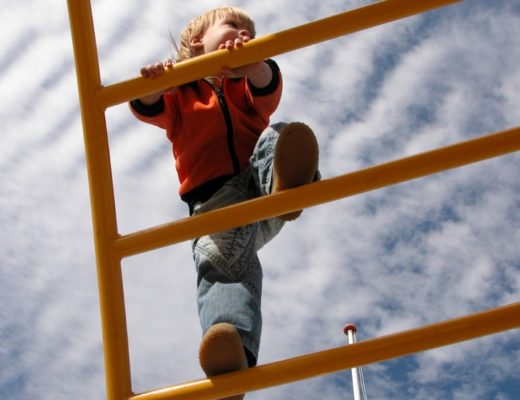
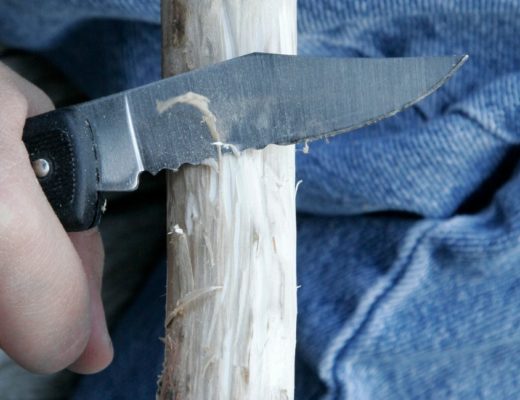
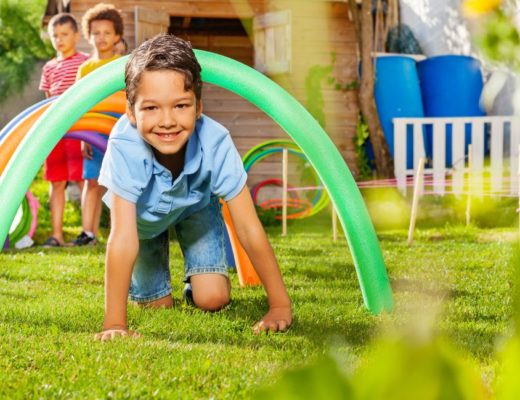

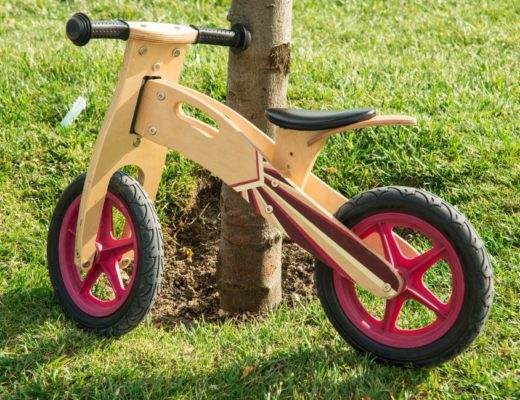
No Comments